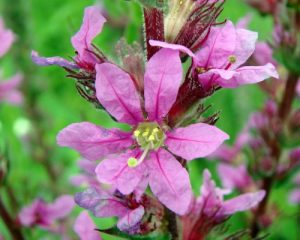 Purple Loosestrife
Purple Loosestrife
Family: Loosestrife, Lythraceae.
Habitat: Wet meadows, flood plains, wetlands, ditches.
Life cycle: Perennial.
Growth Habit: Usually 2- 4 feet tall, but may reach up to 10 feet in nutrient-rich habitats.
Leaves: Opposite or whorled, 1.5-4 inches long with smooth margins, lacking petioles. Lower leaves have downy hairs and clasp the stem.
Stem: Stiff, 4-sided, woody at the base.
Flower: July to early September. Long spikes of rose or purple flowers, each with 4-7 wrinkled petals.
Similar plants: Flowers of native loosestrife are more widely spaced along the stem than those of purple loosestrife.
The problem is…. Purple loosestrife is a strikingly beautiful plant that has escaped from cultivation. (It is an introduced species.) This plant invades wetland habitats, crowding out native plants that are important food sources for wildlife. A single stalk of purple loosestrife can produce 300,000 seeds. Purple loosestrife also spreads vegetatively. This species and its cultivated varieties are noxious weeds in Ohio. Related species are allowed to be sold in Ohio, but some states ban the entire genus.
Currently there are 21 weeds on the Ohio Prohibited Noxious Weed List:
- Shattercane (Sorghum bicolor) – February 8
- Russian thistle (Salsola Kali var. tenuifolia) – February 22
- Johnsongrass (Sorghum halepense L. (Pers.))
- Wild parsnip (Pastinaca sativa)
- Wild carrot (Queen Anne’s lace) (Daucus carota L.)
- Oxeye daisy (Chrysanthermum leucanthemum var. pinnatifidum)
- Wild mustard (Brassica kaber var. pinnatifida)
- Grapevines: when growing in groups of one hundred or more and not pruned, sprayed,cultivated, or otherwise maintained for two consecutive years. – February 15
- Canada thistle (Cirsium arvense L. (Scop.)) – March 29
- Poison hemlock (Conium maculatum)
- Cressleaf groundsel (Senecio glabellus)
- Musk thistle (Carduus nutans) – March 26
- Purple loosestrife (Lythrum salicaria) – April 17
- Mile-A-Minute Weed (Polygonum perfoliatum) – March 7
- Giant Hogweed (Heracleum mantegazzianum) – March 14
- Apple of Peru (Nicandra physalodes) – February 28
- Marestail (Conyza canadensis)
- Kochia (Bassia scoparia)
- Palmer amaranth (Amaranthus palmeri)
- Kudzu (Pueraria montana var. lobata) – April 11
- Japanese Knotweed (Polygonum cuspidatum) – April 2
Each week, for the next 21 weeks, I will post information and pictures on how to identify these invasive and harmful plants.




